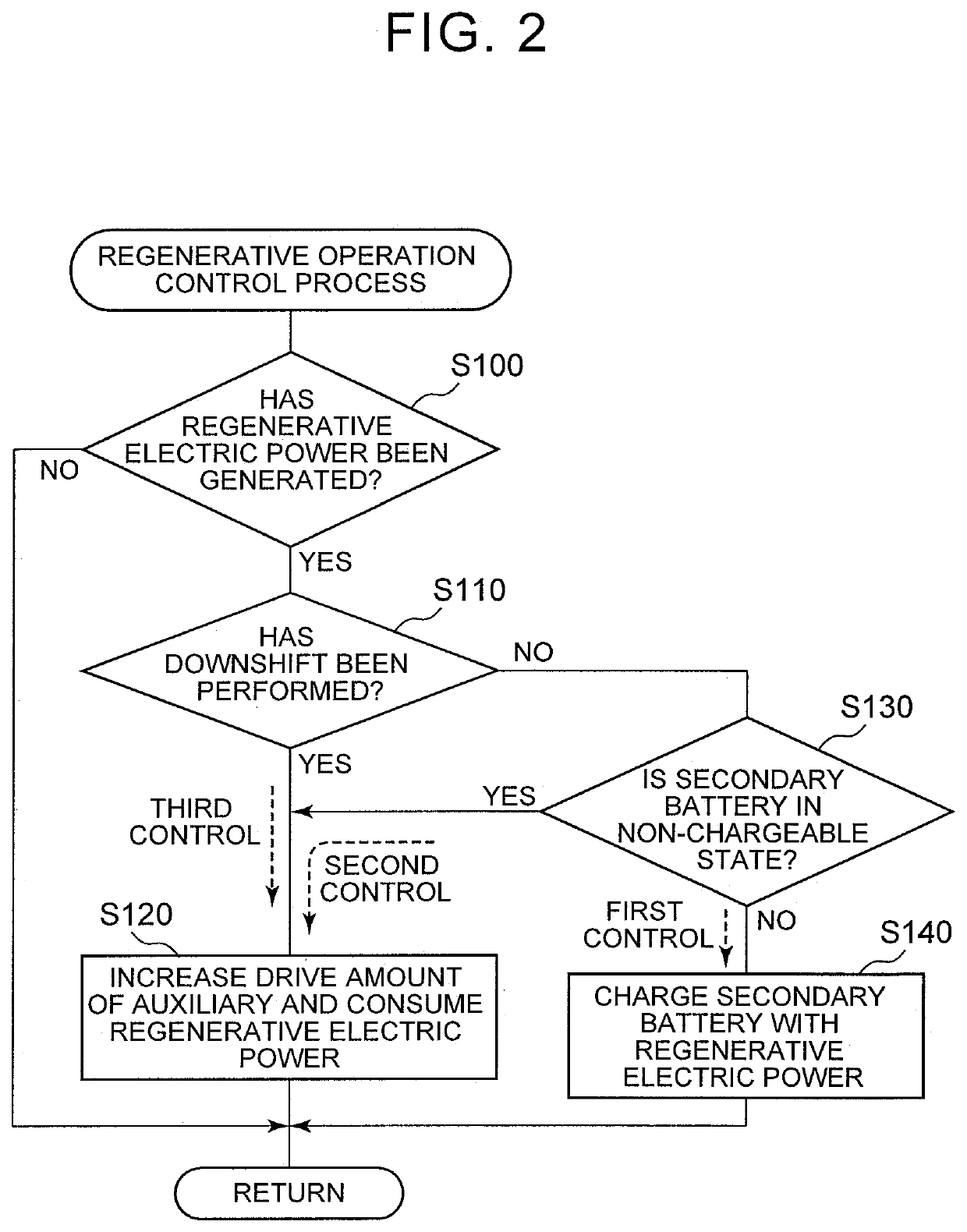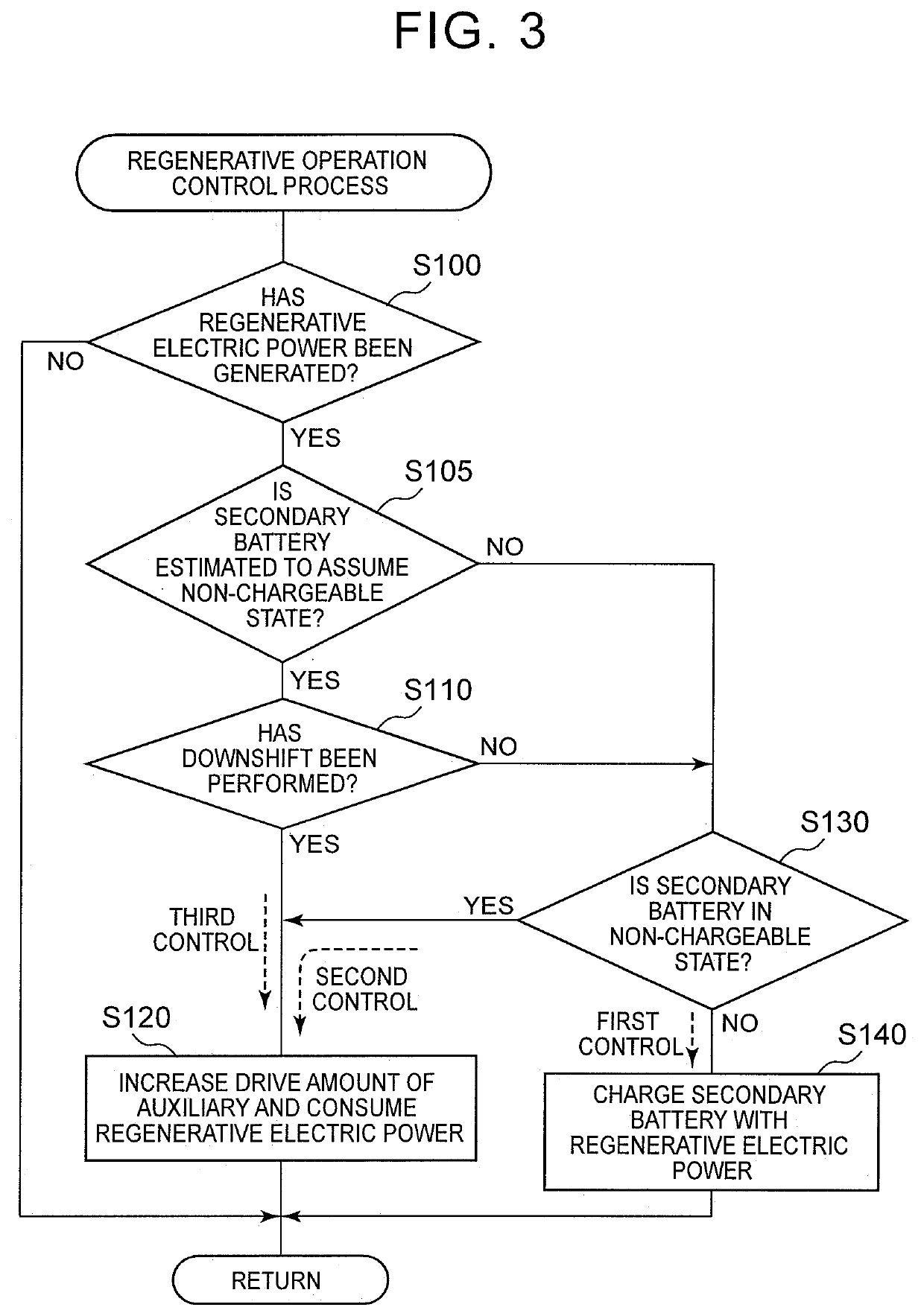Vehicle and method of controlling vehicle
a technology of vehicle and control device, which is applied in the direction of battery/fuel cell control arrangement, transportation and packaging, etc., can solve the problems of secondary battery not being charged, consuming the regenerative electric power of secondary, and all of a sudden consuming regenerative electric power, so as to prevent the noise of the driving auxiliaries
- Summary
- Abstract
- Description
- Claims
- Application Information
AI Technical Summary
Benefits of technology
Problems solved by technology
Method used
Image
Examples
first embodiment
A. First Embodiment
[0023](A-1) General Configuration of Fuel Cell Vehicle:
[0024]FIG. 1 is an illustrative view schematically showing the overall configuration of a fuel cell vehicle 10 as the first embodiment. The fuel cell vehicle 10 is equipped with a fuel cell system 15, an electric power circuit 600, a heating system 700, a drive motor 820, and a control unit 900. The fuel cell system 15 is equipped with a fuel cell 660, a fuel gas supply system 200, an oxidation gas supply system 300, an exhaust gas system 400, and a cooling system 500.
[0025]The fuel cell 660 has a stack configuration in which a plurality of single cells are laminated on one another, and generates electric power by being supplied with fuel gas containing hydrogen and oxidation gas containing oxygen. The fuel cell 660 according to the present embodiment is a polymer electrolyte fuel cell. In each of the single cells constituting the fuel cell 660, a flow channel (an anode-side flow channel) through which fuel ga...
second embodiment
B. Second Embodiment
[0059]FIG. 3 is a flowchart representing a regenerative operation control process routine that is performed by the control unit 900 of the fuel cell vehicle 10 according to the second embodiment. The fuel cell vehicle 10 according to the second embodiment is similar in configuration to the fuel cell vehicle 10 according to the first embodiment, so detailed description thereof will be omitted. The flowchart of FIG. 3 and the flowchart of the first embodiment shown in FIG. 2 have something in common. Therefore, common steps are denoted by the same step numbers respectively, and detailed description thereof will be omitted.
[0060]In the fuel cell vehicle 10 according to the second embodiment as well as the first embodiment, the first control, the second control and the third control can be performed. The second embodiment is different from the first embodiment in that it is determined whether or not the secondary battery 650 is estimated to assume the non-chargeable ...
third embodiment
C. Third Embodiment
[0067]FIG. 4 is a flowchart representing a regenerative operation control process routine that is executed by the control unit 900 of the fuel cell vehicle 10 according to the third embodiment. The fuel cell vehicle 10 according to the third embodiment is similar in configuration to the fuel cell vehicle 10 according to the first embodiment, so detailed description thereof will be omitted. The flowchart of FIG. 4 and the flowchart of the first embodiment shown in FIG. 2 have something in common. Therefore, common steps are denoted by the same step numbers respectively, and detailed description thereof will be omitted.
[0068]The first control, the second control and the third control can be performed in the fuel cell vehicle 10 according to the third embodiment as well as the first embodiment. The third embodiment is different from the first embodiment in that the auxiliaries for use are prioritized when the second control and the third control are performed to caus...
PUM
 Login to View More
Login to View More Abstract
Description
Claims
Application Information
 Login to View More
Login to View More - R&D
- Intellectual Property
- Life Sciences
- Materials
- Tech Scout
- Unparalleled Data Quality
- Higher Quality Content
- 60% Fewer Hallucinations
Browse by: Latest US Patents, China's latest patents, Technical Efficacy Thesaurus, Application Domain, Technology Topic, Popular Technical Reports.
© 2025 PatSnap. All rights reserved.Legal|Privacy policy|Modern Slavery Act Transparency Statement|Sitemap|About US| Contact US: help@patsnap.com



